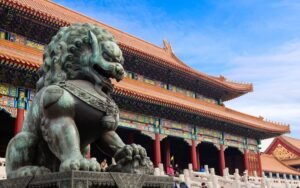Table of Contents
ToggleIntroduction
In the intricate tapestry of Chinese grammar, few elements are as versatile and essential as the particle 的 (de). This small but mighty character serves as a linguistic Swiss Army knife, performing a variety of crucial functions in sentence construction, modification, and expression of possession. For students embarking on their Chinese language journey, mastering the use of 的 is a significant milestone that opens doors to more sophisticated communication and deeper understanding of the language’s nuances.
At LC Chinese School in Oslo, we recognize the pivotal role that particles like 的 play in achieving true fluency in Mandarin Chinese. Our flexible classes are meticulously designed to help students grasp these fundamental concepts while progressing at their own pace, ensuring a solid foundation for advanced language skills. To learn more about our tailored approach to Chinese language education and how we can support your learning goals, visit https://lcchineseschool.com/flexible-classes/.
In this comprehensive guide, we’ll delve deep into the multifaceted nature of 的, exploring its various applications, comparing it to similar constructions in English, and providing numerous examples to illustrate its usage. By the end of this article, you’ll have a profound appreciation for this indispensable particle and be better equipped to use it confidently in your Chinese language practice.
1. The Fundamental Function: Expressing Possession
1.1 Basic Possessive Structures
At its core, 的 serves as a possessive marker, analogous to the apostrophe + s (‘s) in English. This primary function allows speakers to clearly indicate ownership or association between entities. Let’s examine some basic examples:
- 学生的书包 (xuésheng de shūbāo) – The student’s backpack
- 中国的文化 (Zhōngguó de wénhuà) – China’s culture
- 我的朋友 (wǒ de péngyou) – My friend
- 老师的办公室 (lǎoshī de bàngōngshì) – The teacher’s office
- 公司的新项目 (gōngsī de xīn xiàngmù) – The company’s new project
In these phrases, 的 connects the possessor (学生, 中国, 我, 老师, 公司) with the possessed (书包, 文化, 朋友, 办公室, 新项目), establishing a clear relationship between the two elements. This structure is fundamental to expressing ownership and belonging in Chinese.
1.2 Complex Possessive Structures
As learners advance, they encounter more complex possessive structures where 的 can be used multiple times to indicate nested relationships. These structures allow for the expression of intricate connections between multiple entities:
- 我朋友的妹妹的男朋友 (wǒ péngyou de mèimei de nán péngyou) – My friend’s younger sister’s boyfriend
- 公司总经理的秘书的办公室 (gōngsī zǒng jīnglǐ de mìshū de bàngōngshì) – The office of the secretary of the company’s general manager
- 李老师的儿子的大学同学的父亲 (Lǐ lǎoshī de érzi de dàxué tóngxué de fùqin) – The father of Teacher Li’s son’s university classmate
- 这座城市最古老的建筑的修复工程的负责人 (zhè zuò chéngshì zuì gǔlǎo de jiànzhú de xiūfù gōngchéng de fùzérén) – The person in charge of the restoration project of the oldest building in this city
These examples demonstrate how 的 can be chained to express intricate possessive relationships, a feature that allows for precise and nuanced expression in Chinese. Mastering these complex structures is crucial for advanced learners aiming to convey sophisticated ideas and relationships.
2. Omission of 的 in Certain Contexts
2.1 Family Relationships
While 的 is generally required to indicate possession, there are situations where it can be omitted without altering the sentence’s meaning. This omission frequently occurs in casual speech or when referring to close relationships, particularly family members:
- 我妈妈 (wǒ māma) instead of 我的妈妈 (wǒ de māma) – My mother
- 他爸爸 (tā bàba) instead of 他的爸爸 (tā de bàba) – His father
- 你姐姐 (nǐ jiějie) instead of 你的姐姐 (nǐ de jiějie) – Your older sister
- 我们奶奶 (wǒmen nǎinai) instead of 我们的奶奶 (wǒmen de nǎinai) – Our grandmother
This omission lends a more intimate and colloquial tone to the expression, reflecting the close nature of family relationships. It’s important to note that while this omission is common in spoken Chinese, it may still be used in written form, especially in more formal contexts.
2.2 Common Expressions and Fixed Phrases
Certain common expressions and fixed phrases also tend to omit 的, particularly when the relationship is clear or commonly understood:
- 学校图书馆 (xuéxiào túshūguǎn) instead of 学校的图书馆 (xuéxiào de túshūguǎn) – School library
- 中国文化 (Zhōngguó wénhuà) instead of 中国的文化 (Zhōngguó de wénhuà) – Chinese culture
- 城市中心 (chéngshì zhōngxīn) instead of 城市的中心 (chéngshì de zhōngxīn) – City center
- 公司员工 (gōngsī yuángōng) instead of 公司的员工 (gōngsī de yuángōng) – Company employees
These omissions contribute to the fluidity and naturalness of spoken Chinese, and mastering them is key to sounding more like a native speaker. However, learners should be cautious not to overgeneralize this rule, as the omission of 的 is not always appropriate and can sometimes change the meaning of a phrase.
3. Comparing English and Chinese Word Order
3.1 The Reversal Principle
One of the challenges for English speakers learning Chinese is adapting to the different word order when using possessive constructions. In English, we often use “of” to express possession, especially with inanimate objects. However, Chinese consistently uses the 的 structure, regardless of whether the possessor is animate or inanimate. The key is to remember that the Chinese order is essentially the reverse of the English “of” construction:
- English: The population of Beijing
- Chinese: 北京的人口 (Běijīng de rénkǒu)
- English: The color of the sky
- Chinese: 天空的颜色 (tiānkōng de yánsè)
- English: The price of the ticket
- Chinese: 票的价格 (piào de jiàgé)
- English: The history of the Ming Dynasty
- Chinese: 明朝的历史 (Míng cháo de lìshǐ)
3.2 Complex Phrases and Extended Examples
This reversal applies to more complex phrases as well, and understanding this principle is crucial for constructing natural-sounding Chinese sentences:
- English: The economic development of countries along the Belt and Road Initiative
- Chinese: 一带一路沿线国家的经济发展 (Yīdài Yīlù yánxiàn guójiā de jīngjì fāzhǎn)
- English: The environmental impact of rapid urbanization in developing countries
- Chinese: 发展中国家快速城市化的环境影响 (fāzhǎn zhōng guójiā kuàisù chéngshìhuà de huánjìng yǐngxiǎng)
- English: The cultural significance of traditional festivals in modern society
- Chinese: 现代社会中传统节日的文化意义 (xiàndài shèhuì zhōng chuántǒng jiérì de wénhuà yìyì)
Mastering this difference in word order is essential for avoiding awkward, directly translated expressions and achieving fluency in Chinese. At LC Chinese School in Oslo, we emphasize this concept in our curriculum, providing ample practice opportunities for students to internalize this crucial aspect of Chinese grammar. For more information on how our classes can help you master these linguistic nuances, visit https://lcchineseschool.com/flexible-classes/.
4. Location Phrases and the Use of 的
4.1 Avoiding Common Mistakes
A frequent error made by English speakers is translating phrases like “in Beijing” or “at the university” directly using the preposition 在 (zài) when modifying a noun. In many cases, Chinese prefers to use the 的 structure to create a more integrated modifier:
- Incorrect: 学生在北京大学都很努力。
- Correct: 北京大学的学生都很努力。(Běijīng Dàxué de xuésheng dōu hěn nǔlì.) Students at Peking University are all very hardworking.
- Incorrect: 空气在山上总是很新鲜。
- Correct: 山上的空气总是很新鲜。(Shānshàng de kōngqì zǒng shì hěn xīnxiān.) The air in the mountains is always very fresh.
- Incorrect: 房子在城市中心很贵。
- Correct: 城市中心的房子很贵。(Chéngshì zhōngxīn de fángzi hěn guì.) Houses in the city center are expensive.
4.2 Emphasizing Relationships and Extended Examples
By using 的 instead of 在, these sentences sound more natural and idiomatic in Chinese. This construction emphasizes the relationship between the location and the subject, rather than treating the location as a separate prepositional phrase. Let’s explore more examples to solidify this concept:
- 海边的度假村很受欢迎。(Hǎibiān de dùjiàcūn hěn shòu huānyíng.) Seaside resorts are very popular.
- 乡村的生活节奏比较慢。(Xiāngcūn de shēnghuó jiézòu bǐjiào màn.) The pace of life in the countryside is relatively slow.
- 大城市的交通常常很拥堵。(Dà chéngshì de jiāotōng chángcháng hěn yōngdǔ.) Traffic in big cities is often very congested.
- 热带地区的水果种类很丰富。(Rèdài dìqū de shuǐguǒ zhǒnglèi hěn fēngfù.) Tropical regions have a rich variety of fruits.
Understanding and applying this usage of 的 will significantly enhance the naturalness and accuracy of your Chinese expressions, particularly when describing characteristics or situations related to specific locations.
5. Omission of Nouns After 的
5.1 Contextual Clarity and Efficiency
In contexts where the referenced noun is clear from the conversation or surrounding text, Chinese often omits the noun following 的. This ellipsis creates more concise expressions and avoids unnecessary repetition, contributing to the efficiency of communication:
A: 这是谁的笔记本电脑?(Zhè shì shéi de bǐjìběn diànnǎo?) Whose laptop is this?
B: 是小李的。(Shì Xiǎo Lǐ de.) It’s Xiao Li’s.
In B’s response, the noun 笔记本电脑 is omitted after 的 because it’s understood from the context. This principle applies to various situations:
- 我的车是红色的,他的是蓝色的。(Wǒ de chē shì hóngsè de, tā de shì lánsè de.) My car is red, his is blue.
- 这件衣服太贵了,我想买便宜的。(Zhè jiàn yīfu tài guì le, wǒ xiǎng mǎi piányi de.) This clothing is too expensive, I want to buy a cheap one.
5.2 Questions, Preferences, and Comparisons
This construction is particularly common in questions and answers about ownership, preference, or when making comparisons:
- 你喜欢哪件衣服?我喜欢蓝色的。 (Nǐ xǐhuan nǎ jiàn yīfu? Wǒ xǐhuan lánsè de.) Which clothes do you like? I like the blue one.
- 这个苹果是甜的,那个是酸的。 (Zhège píngguǒ shì tián de, nàge shì suān de.) This apple is sweet, that one is sour.
- 你要大号的还是小号的? (Nǐ yào dà hào de háishi xiǎo hào de?) Do you want the large size or the small size?
Mastering this aspect of 的 usage allows for more concise and natural expression in Chinese, particularly in everyday conversations and when discussing preferences or making comparisons.
6. 的 in Adjectival Phrases
6.1 Forming Descriptive Modifiers
Beyond indicating possession, 的 plays a crucial role in forming adjectival phrases. In this usage, 的 connects a descriptive element to the noun it modifies, creating a more complex and nuanced description:
- 勤奋的学生总是取得好成绩。 (Qínfèn de xuésheng zǒng shì qǔdé hǎo chéngjī.) Diligent students always achieve good results.
- 美丽的风景吸引了许多游客。 (Měilì de fēngjǐng xīyǐn le xǔduō yóukè.) Beautiful scenery attracts many tourists.
- 复杂的问题需要仔细思考。 (Fùzá de wèntí xūyào zǐxì sīkǎo.) Complex problems require careful consideration.
- 新鲜的水果对健康有益。 (Xīnxiān de shuǐguǒ duì jiànkāng yǒuyì.) Fresh fruits are beneficial to health.
6.2 Compound Adjectives and Extended Descriptions
的 is also used to form compound adjectives, combining multiple descriptive elements to create more detailed and vivid descriptions:
- 红色的大房子 (hóngsè de dà fángzi) – A big red house
- 又高又帅的男生 (yòu gāo yòu shuài de nánshēng) – A tall and handsome boy
- 干净整洁的办公室 (gānjìng zhěngjié de bàngōngshì) – A clean and tidy office
- 古色古香的中国建筑 (gǔsè gǔxiāng de Zhōngguó jiànzhú) – Traditional Chinese architecture with an antique flavor
Moreover, 的 can be used to create more complex adjectival phrases that incorporate verbal elements or longer descriptions:
- 刚从国外回来的朋友 (gāng cóng guówài huílái de péngyou) A friend who just returned from abroad
- 令人难忘的经历 (lìng rén nánwàng de jīnglì) An unforgettable experience
- 充满希望的未来 (chōngmǎn xīwàng de wèilái) A future full of hope
- 经过精心设计的产品 (jīngguo jīngxīn shèjì de chǎnpǐn) A meticulously designed product
Understanding and mastering the use of 的 in forming adjectival phrases is crucial for creating rich, descriptive language in Chinese. This skill allows learners to express complex ideas and paint vivid pictures with their words, enhancing both written and spoken communication.
7. 的 in Relative Clauses
7.1 Forming Basic Relative Clauses
In Chinese, 的 is essential in forming relative clauses, which modify nouns by providing additional information. This usage of 的 is comparable to relative pronouns (who, which, that) in English:
- 我昨天买的书很有趣。 (Wǒ zuótiān mǎi de shū hěn yǒuqù.) The book I bought yesterday is very interesting.
- 住在北京的外国人越来越多。 (Zhù zài Běijīng de wàiguó rén yuè lái yuè duō.) The number of foreigners living in Beijing is increasing.
- 他写的文章被许多杂志刊登。 (Tā xiě de wénzhāng bèi xǔduō zázhì kāndēng.) The articles he writes are published in many magazines.
7.2 Complex Relative Clauses
As learners advance, they encounter more complex relative clauses where 的 plays a pivotal role in connecting longer descriptive phrases to the nouns they modify:
- 他给我介绍的那个朋友是一位著名的画家。 (Tā gěi wǒ jièshào de nà ge péngyou shì yī wèi zhùmíng de huàjiā.) The friend he introduced to me is a famous painter.
- 我们正在讨论的这个问题对公司的未来至关重要。 (Wǒmen zhèngzài tǎolùn de zhège wèntí duì gōngsī de wèilái zhìguān zhòngyào.) The issue we’re currently discussing is crucial to the company’s future.
- 去年在这里举办的音乐节吸引了成千上万的观众。 (Qùnián zài zhèlǐ jǔbàn de yīnyuè jié xīyǐn le chéngqiān shàngwàn de guānzhòng.) The music festival held here last year attracted tens of thousands of spectators.
Mastering the use of 的 in relative clauses allows learners to construct more sophisticated sentences and express complex ideas more clearly and concisely in Chinese.
8. 的 in Nominalization
8.1 Creating Noun Phrases
的 can be used to transform other parts of speech, particularly adjectives, into noun phrases. This process, known as nominalization, is useful for referring to specific items or concepts:
- 红的 (hóng de) – The red one
- 大的 (dà de) – The big one
- 便宜的 (piányi de) – The cheap one
- 最新的 (zuì xīn de) – The newest one
This usage is particularly useful when referring to items or concepts previously mentioned in a conversation, allowing for more concise and context-dependent communication.
8.2 Abstract Concepts and Qualities
的 can also be used to create abstract nouns from adjectives or verbs, allowing speakers to discuss qualities or concepts in a more generalized way:
- 美丽的 (měilì de) – Beauty / The beautiful aspect
- 重要的 (zhòngyào de) – Importance / The important thing
- 有趣的 (yǒuqù de) – The interesting part
- 困难的 (kùnnan de) – The difficult aspect
This usage of 的 enables speakers to discuss abstract ideas and qualities more easily, contributing to more nuanced and philosophical discussions in Chinese.
9. Common Mistakes and How to Avoid Them
9.1 Overuse of 的
One common mistake among learners is the overuse of 的, particularly in situations where it can be omitted. This often occurs with family relationships or in fixed expressions:
- Incorrect: 我的妈妈的朋友
- Correct: 我妈妈的朋友 (Wǒ māma de péngyou) – My mother’s friend
- Incorrect: 北京的大学的学生
- Correct: 北京大学的学生 (Běijīng dàxué de xuésheng) – Students of Beijing University
To avoid this, learners should practice recognizing contexts where 的 can be naturally omitted, particularly in spoken Chinese and with familiar relationships.
9.2 Incorrect Word Order
Another frequent error is applying English word order to Chinese possessive structures, particularly when translating phrases using “of”:
- Incorrect: 颜色的天空 (direct translation of “color of the sky”)
- Correct: 天空的颜色 (Tiānkōng de yánsè) – The color of the sky
- Incorrect: 首都的中国 (direct translation of “capital of China”)
- Correct: 中国的首都 (Zhōngguó de shǒudū) – The capital of China
To overcome this, learners should practice thinking in the Chinese structure rather than translating directly from English. Regular exposure to authentic Chinese materials and practice in constructing sentences can help reinforce the correct word order.
9.3 Misuse in Location Phrases
As discussed earlier, learners often mistakenly use 在 (zài) instead of 的 when describing characteristics of a location:
- Incorrect: 学生在北京大学都很聪明。
- Correct: 北京大学的学生都很聪明。(Běijīng Dàxué de xuésheng dōu hěn cōngming.) Students at Peking University are all very intelligent.
To avoid this, practice forming location-based descriptions using 的 and be mindful of the difference between describing a characteristic of a place (use 的) and describing an action occurring at a place (use 在).
10. Advanced Applications of 的
10.1 的 in Emphatic Structures
In certain structures, 的 can be used for emphasis or to create a stronger assertion:
- 他是一定要去的。(Tā shì yīdìng yào qù de.) He is definitely going to go. (Emphasizing the certainty)
- 这本书我是看过的。(Zhè běn shū wǒ shì kàn guo de.) I have indeed read this book. (Emphasizing the fact of having read it)
10.2 的 in Rhetorical Questions
的 can be used in forming rhetorical questions, often to express strong emotion or emphasis:
- 谁说的?(Shéi shuō de?) – Who said that? (Implying disbelief or challenge)
- 你在说什么的?(Nǐ zài shuō shénme de?) – What are you talking about? (Expressing confusion or disagreement)
10.3 的 in Idiomatic Expressions
Many Chinese idiomatic expressions and proverbs use 的 in unique ways:
- 不见不散的 (Bú jiàn bú sàn de) – We must meet (lit. “Not seeing, not dispersing”)
- 来者不拒的 (Lái zhě bù jù de) – Welcoming all comers (lit. “Not refusing those who come”)
Understanding these advanced applications of 的 can significantly enhance a learner’s ability to express nuanced meanings and engage with Chinese culture at a deeper level.
Conclusion
Mastering the use of 的 is a crucial step in achieving fluency in Chinese. Its versatility in expressing possession, forming adjectives, creating relative clauses, and more makes it an indispensable tool in the Chinese language learner’s toolkit. From basic possessive structures to complex nominalization and idiomatic usage, 的 plays a central role in constructing clear, natural, and sophisticated Chinese sentences.
At LC Chinese School in Oslo, we emphasize the importance of particles like 的 in our curriculum, ensuring that students develop a strong foundation in Chinese grammar. Our flexible classes are designed to accommodate learners at various levels, allowing them to progress at their own pace while receiving personalized guidance. Whether you’re just starting your Chinese language journey or looking to refine your skills, our experienced instructors are here to help you navigate the intricacies of Chinese grammar, including the many uses of 的.
Remember, mastering 的 is not just about memorizing rules, but about understanding its role in creating meaning and nuance in Chinese. Regular practice, exposure to authentic materials, and continuous application in various contexts are key to internalizing its usage.
To learn more about our flexible class options and how we can support your Chinese language learning goals, visit https://lcchineseschool.com/flexible-classes/. Join us in exploring the fascinating world of Chinese grammar and take your language skills to the next level!
By thoroughly understanding and applying the principles outlined in this guide, you’ll be well on your way to mastering one of the most fundamental and versatile elements of Chinese grammar. The journey to fluency is ongoing, and with each step, you’ll find new depths and nuances in the use of 的 and other essential components of the Chinese language.







